Contents
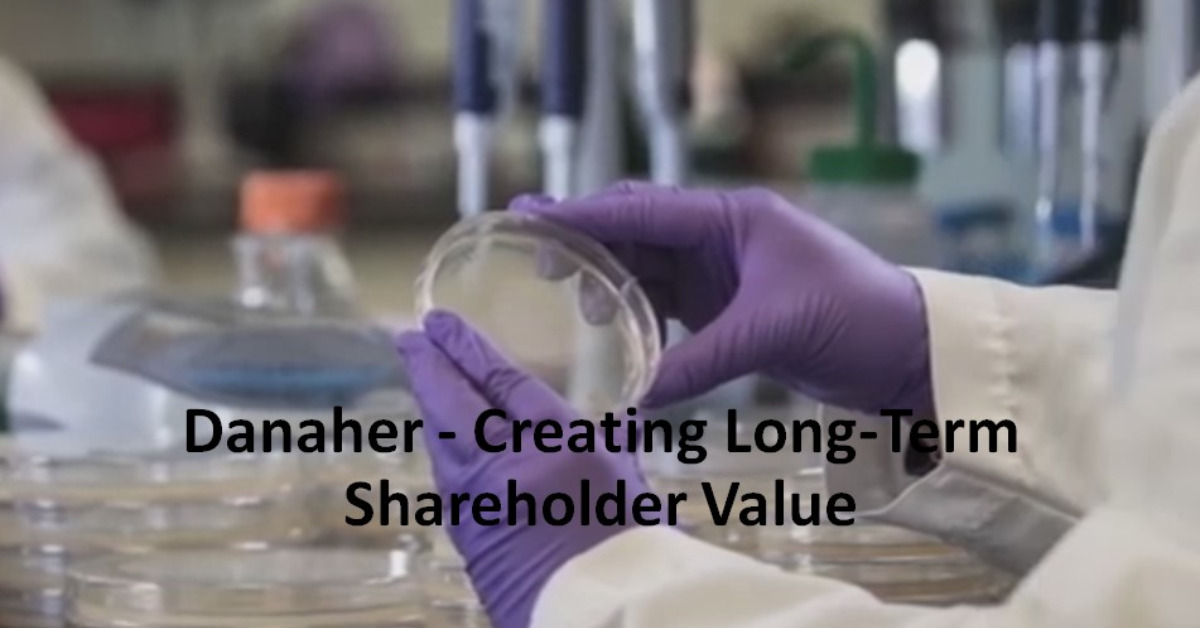
Danaher (DHR) is creating long-term shareholder value. Over a 10-year timeframe, the average annual total return with the reinvestment of dividends is 22.07% and 21.73% without the reinvestment of dividends. In contrast, the returns from the S&P500 are 14.69% and 13.65% (source: www.tickertech.com).
Despite viewing DHR’s valuation to be somewhat rich, I initiated a small position on January 4, 2022; I acquired 50 shares @ $307/share on January 4, 2022 in one of the ‘Core’ accounts within the FFJ Portfolio and disclosed this purchase in my January 6 post. Although the valuation was not favourable, I planned to add to my position if DHR’s valuation improved.
Shortly after my initial purchase, DHR’s valuation began to improve and by the time I wrote my January 28 post, my exposure was 160 shares.
In February, we had the good fortune of some broad market weakness and DHR’s valuation further improved. I, therefore, increased my exposure to 210 shares on February 17, 2022 and disclose this in my FFJ Portfolio – February 2022 Report.
My average cost is now ~$289 and I am cautiously optimistic I can reduce this further.
With the release of Q1 2022 results on April 21, 2022, I now look to see if this might be an opportune time to add to my position.
Overview
DHR uses its proven Danaher Business System (DBS) to continuously improve its scientific technology portfolio. It seeks attractive markets and then makes acquisitions to enter or expand within specific niches.
Following an acquisition, DHR will make R&D and marketing-related investments to accelerate core growth at its acquired companies. Furthermore, DHR implements lean manufacturing principles and administrative cost controls to boost operating margins.
DHR’s strategic moves have pushed it into attractive end markets with strong growth prospects and sticky, recurring revenue streams. Through FY2019 – FY2021, DHR’s recurring revenue as a percentage of total revenue is 68.7%, 71.7%, and 74%. In Q1 2021 and Q1 2022, recurring revenue as a percentage of total revenue is 74% and 76.7%, respectively.
In under 20 years, DHR has become a top-5 player in the highly fragmented and relatively sticky life science and diagnostic space; Radiometer was its first acquisition in 2004.
The DHR Business Directory includes links to the entities within DHR’s 3 segments (Life Sciences, Diagnostics, and Environmental & Applied Solutions).
Financials
Q1 2022 Results
I encourage you to read DHR’s Form 10-Q, Earnings Release and Earnings Presentation which are accessible here.
In Q1, DHR reported mid-teens revenue growth in the US and Western Europe and low single-digit growth in high-growth markets.
China declined low single-digit but was up high single-digit. The COVID-19-driven lockdowns that began in late March had a very modest impact on DHR’s Q1 results in China. However, as these lockdowns extend further into April, DHR is seeing more of an impact on its businesses. Regional lockdowns are negatively impacting patient volumes but management anticipates the situation will begin to ease in the coming weeks with an eventual return to normalized activity levels by the end of June.
The following provides a glimpse of DHR’s Q1 results.
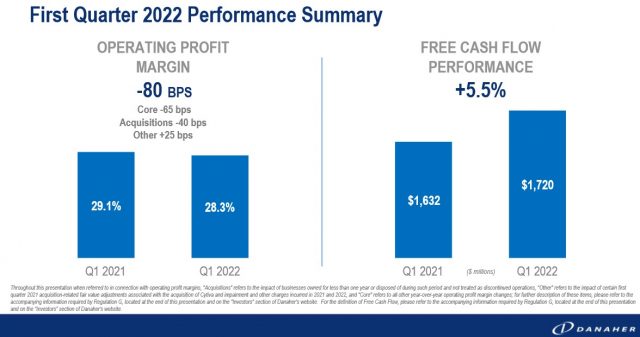
Source: DHR – Q1 2022 Earnings Presentation – April 21, 2022
This is DHR’s Q1 segment information:
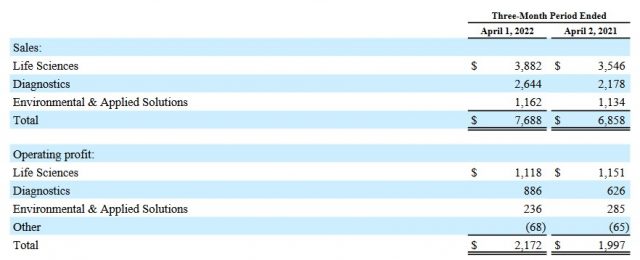
Source: DHR – Q1 2022 Form 10-Q
The Q4 2020, Q4 2021, FY2020, and FY2021 segment information is provided for comparison.
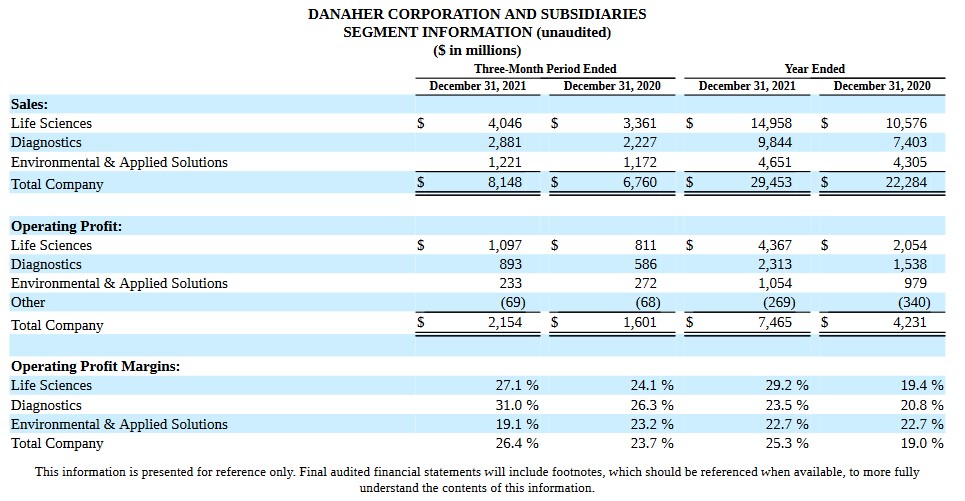
Source: DHR – Form 8-K January 27, 2022
DHR, like so many other companies, continues to experience ongoing supply chain constraints and inflationary pressures. It is, however, proactively addressing these challenges by leveraging the (DBS) and working closely with customers and suppliers to mitigate the impact. It is also continuing to use the DBS to accelerate price action and manage cost pressures.
Operating Cash Flow (OCF) and Free Cash Flow (FCF)
Since DHR actively acquires and divests assets, its diluted EPS is deceiving. ‘Amortization of intangible assets’ and ‘amortization of acquisition-related inventory fair value step-up’ are two large line items that consistently appear in the Consolidated Condensed Statements of Cash Flows. Investors should, therefore, pay particularly close attention to DHR’s OCF and FCF.
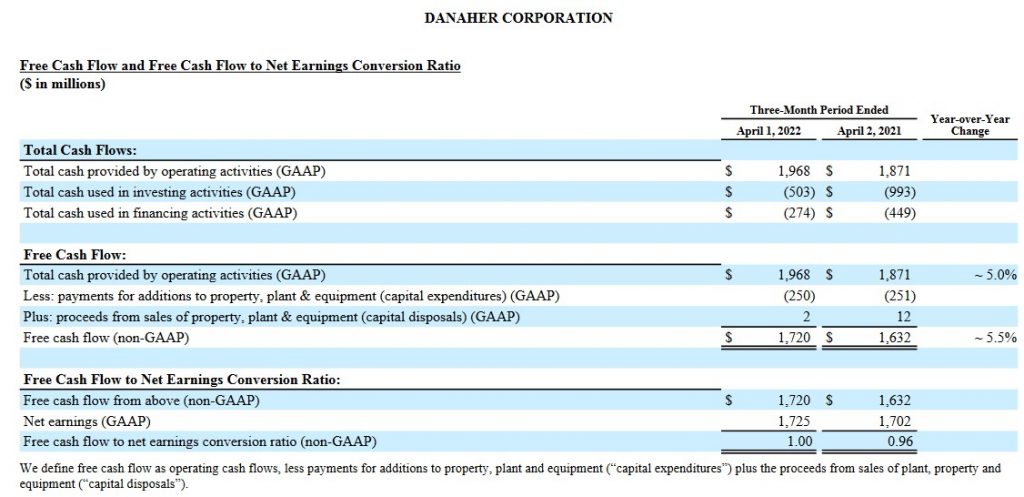
Source: Reconciliation of GAAP and non-GAAP Financial Measures for Q1 2021 and 2022 – April 21, 2022
The following table reflects the conversion rate for Q4 2020, Q4 2021, FY2020, and FY2021 and is provided for comparison.
DHR’s FY2021 FCF to net income conversion was 112% making it the 30th consecutive year this figure exceeds 100%.
FY2022 Outlook
Management’s expectation for Q2 is mid-single-digit core revenue growth. This includes a headwind from the ongoing COVID-19-related shutdowns in China of ~200 – 300 basis points.
There is no change to DHR’s FY2022 previous guidance of high single-digit core revenue growth in the base business if the shutdowns in China normalize as the year progresses.
Credit Ratings
We see from DHR’s debt schedule as of the end of Q1 2022 that debt has been raised at very attractive rates. Furthermore, maturity dates are well balanced and go far out on the calendar.
Retail investors are highly unlikely to raise financing under such attractive terms and conditions. Investing in DHR, however, provides investors with the opportunity to benefit from DHR’s ability to negotiate very favourable financing arrangements!
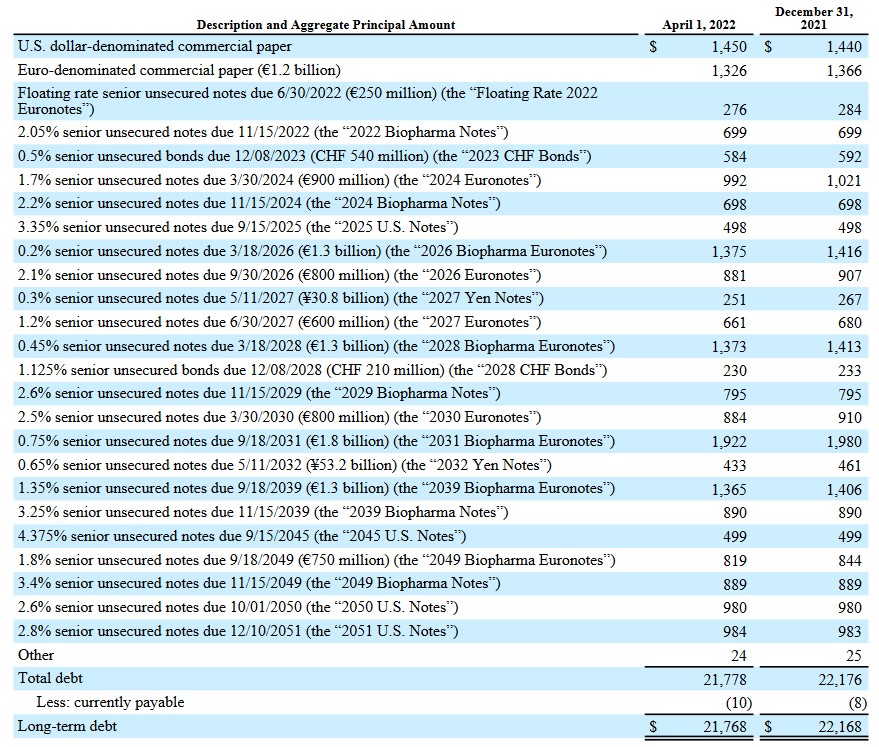
Source: DHR – Q1 2022 Form 10-Q
DHR’s credit ratings remain unchanged from those reflected in my previous posts. The ratings and outlook are:
- Moody’s: Baa1 with a stable outlook;
- S&P Global: BBB+ with a positive outlook.
Both ratings are the top tier of the lower-medium-grade investment-grade tier. These ratings define DHR as having the ADEQUATE capacity to meet its financial commitments. However, adverse economic conditions or changing circumstances are more likely to lead to a weakened capacity to meet its financial commitments.
These ratings satisfy my conservative investment profile.
Dividend and Dividend Yield
DHR distributes a quarterly dividend. On February 23, 2022, DHR declared a $0.25/share quarterly dividend for distribution on April 29, 2022, to shareholders of record on March 25, 2022. This is a ~19% increase from the prior $0.21/share quarterly dividend.
At the time of my January 28 post, the dividend yield was ~0.3% ($0.21/share quarter and a ~$270 share price). Shares are now trading at $278.55 so the current dividend yield is ~0.36%.
Investors who rely on dividend income might immediately pass on investing in DHR because of this low dividend yield. However, I have mentioned in several previous posts that:
Investors should not fixate on dividend metrics. The focus should be on total potential long-term investment returns.
We have seen that DHR raises attractive financing and has demonstrated its ability to generate attractive returns. By retaining funds in the company, DHR has a better probability of creating long-term shareholder value.
On July 16, 2013, DHR’s Board approved a repurchase program authorizing the repurchase of up to 20 million shares from time to time on the open market or in privately negotiated transactions. DHR did not repurchase any shares in Q1 2022 and as of April 1, 2022, 20 million shares remained available for repurchase.
At the end of Q1 2022, DHR also had two series (Series A and B) of Mandatory Conversion Preferred Shares (MCPS).
These MCPS were issued to help finance the 2020 acquisition of the Biopharma business of the General Electric Company’s Life Sciences division (now names Cytiva) for a cash purchase price of ~$20.7B.
On April 15, 2022, all outstanding shares of the 4.75% MCPS Series A converted at a rate of 6.6632 common shares per share of preferred stock into an aggregate of 11.0 million shares of the Company’s common stock; DHR issued cash instead of fractional shares of common stock in the conversion. The final $11.875/share quarterly cash dividend was paid on April 15, 2022.
The remaining 5% MCPS Series B carries an April 15, 2023 mandatory conversion date.
Although DHR periodically repurchases shares, the diluted average common stock and common equivalent shares outstanding (in millions) in FY2012 – FY2021 are 713, 711, 716, 709, 700, 706, 710, 726, 719 and 737. The average common stock and common equivalent shares outstanding in Q1 2022 is 737.7.
As noted earlier, DHR actively acquires and divests entities. The fluctuation in the outstanding number of shares is dependent to an extent on its acquisitions and divestitures.
Valuation
DHR’s FY2012 – FY2021 diluted PE levels are 17.31, 21.56, 22.44, 25.80, 19.66, 27.63, 26.51, 45.41, 51.90, and 42.34. DHR, however, has undergone a radical transformation over the last few years after having divested slower-growing businesses and acquiring several faster-growing businesses. We can not, therefore, merely compare YoY PE levels.
When I initiated my DHR position in early January 2022, shares were trading at ~$307. The forward adjusted diluted PE levels based on EPS estimates from the 2 online brokerage platforms I use were:
- FY2021 – 20 brokers – mean of $9.83 and low/high of $9.40 – $10.01. Using the mean estimate, the forward adjusted diluted PE was ~31.
- FY2022 – 21 brokers – mean of $10.19 and low/high of $9.58 – $10.90. Using the mean estimate, the forward adjusted diluted PE was ~30.
- FY2023 – 15 brokers – mean of $10.65 and low/high of $9.45 – $11.31. Using the mean estimate, the forward adjusted diluted PE was ~29.
When shares closed at ~$270 on January 27, DHR had reported FY2021 diluted EPS of $8.50 giving us a diluted PE of ~31.8.
FCF to net income conversion was 112% and this was the 30th consecutive year in which this ratio exceeded 100% ($8.50 * 1.12 = ~$9.50 FCF/share).
Using the current ~$270 share price and $9.50 FCF/share, the P/FCF was ~28.4.
Based on DHR’s ~$270 share price and the following forward adjusted diluted EPS estimates, DHR’s valuation was:
- FY2022 – 23 brokers – mean of $10.43 and low/high of $9.89 – $11.01. Using the mean estimate, the forward adjusted diluted PE was ~26.
- FY2023 – 19 brokers – mean of $10.99 and low/high of $10.25 – $12. Using the mean estimate, the forward adjusted diluted PE was ~24.6.
- FY2024 – 11 brokers – mean of $12.18 and low/high of $11.15 – $13.5. Using the mean estimate, the forward adjusted diluted PE was ~22.
Using DHR’s current $278.55 share price and the current forward adjusted diluted EPS estimates (revisions are likely over the coming days), DHR’s forward adjusted diluted PE levels are:
- FY2022 – 23 brokers – mean of $10.45 and low/high of $9.99 – $10.61. Using the mean estimate, the forward adjusted diluted PE is ~26.7.
- FY2023 – 22 brokers – mean of $10.98 and low/high of $10.20 – $11.60. Using the mean estimate, the forward adjusted diluted PE is ~25.4.
- FY2024 – 10 brokers – mean of $12.24 and low/high of $11.71 – $13.4. Using the mean estimate, the forward adjusted diluted PE is ~22.8.
Historically, DHR’s full-year FCF/share has exceeded EPS. The FCF from continuing operations to net earnings from continuing operations conversion ratio was 1.49 and 1.12 in FY2020 and FY2021. Every quarter, however, the FCF to net earnings conversion ratio might not exceed 1. In Q1 2021, for example, the conversion ratio was 0.96 and in Q1 2022 it is 1.
I envision DHR’s full-year FCF to net earnings conversion ratio will continue to exceed 1, and therefore, expect the forward valuation based on FCF to be superior to that based on EPS.
Final Thoughts
Steven and Mitchell Rales acquired a Real Estate Investment Trust in 1983 and merged it into their firm Danaher, named after a creek in Montana. On the Forbes 2022 World’s Billionaires List, Steven is ranked #252 with a Net Worth of ~$8.7B and Mitchell is ranked #441 with a Net Worth of ~$5.9B; this list is updated in real-time. The Rales brothers have demonstrated they know how to create wealth and I suggest investors may want to ‘follow the money’.
Despite its forward valuation being less attractive than at the time of my February 17, 2022 purchase at $268.25/share, DHR creates long-term shareholder value. I intend to acquire additional shares.
I wish you much success on your journey to financial freedom!
Note: Please send any feedback, corrections, or questions to finfreejourney@gmail.com.
Disclosure: I am long DHR.
Disclaimer: I do not know your circumstances and do not provide individualized advice or recommendations. I encourage you to make investment decisions by conducting your research and due diligence. Consult your financial advisor about your specific situation.
I wrote this article myself and it expresses my own opinions. I do not receive compensation for it and have no business relationship with any company mentioned in this article.



